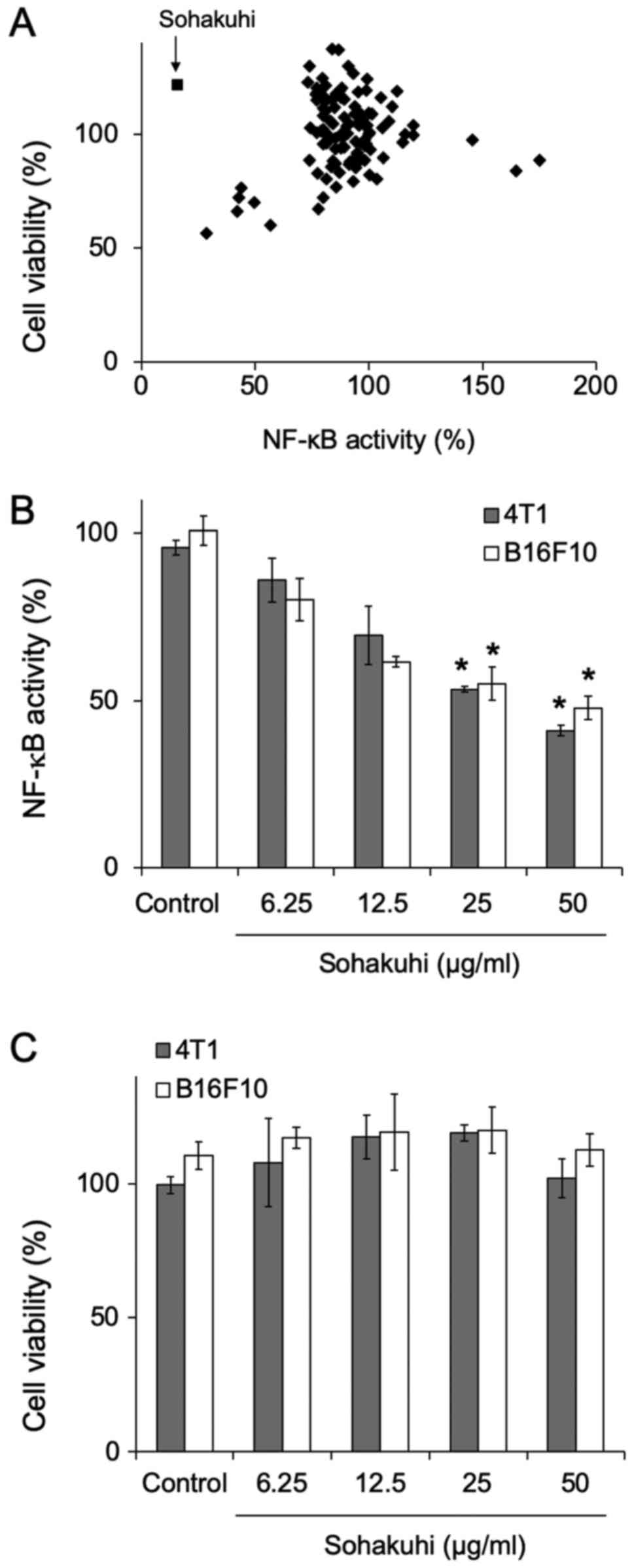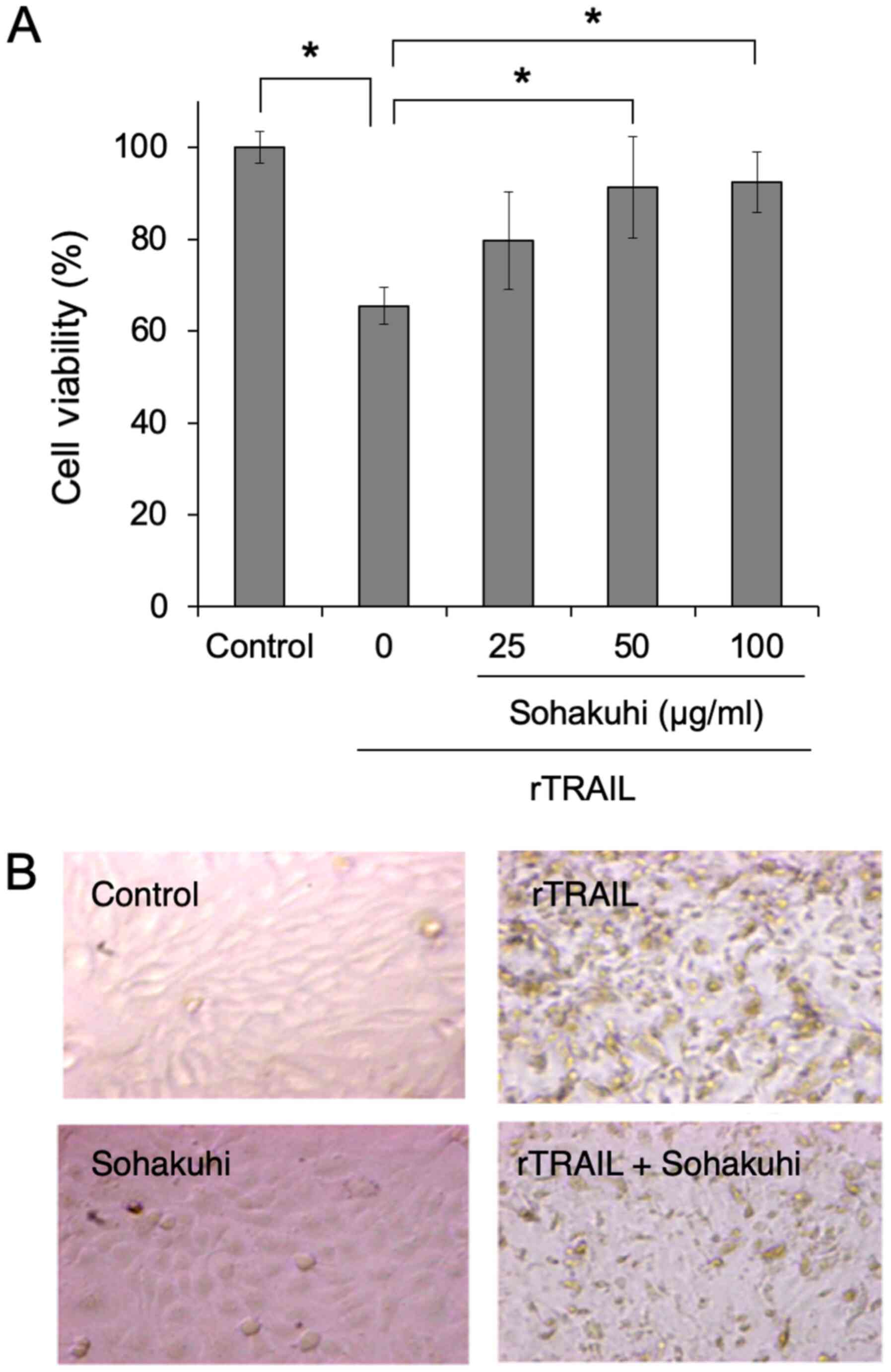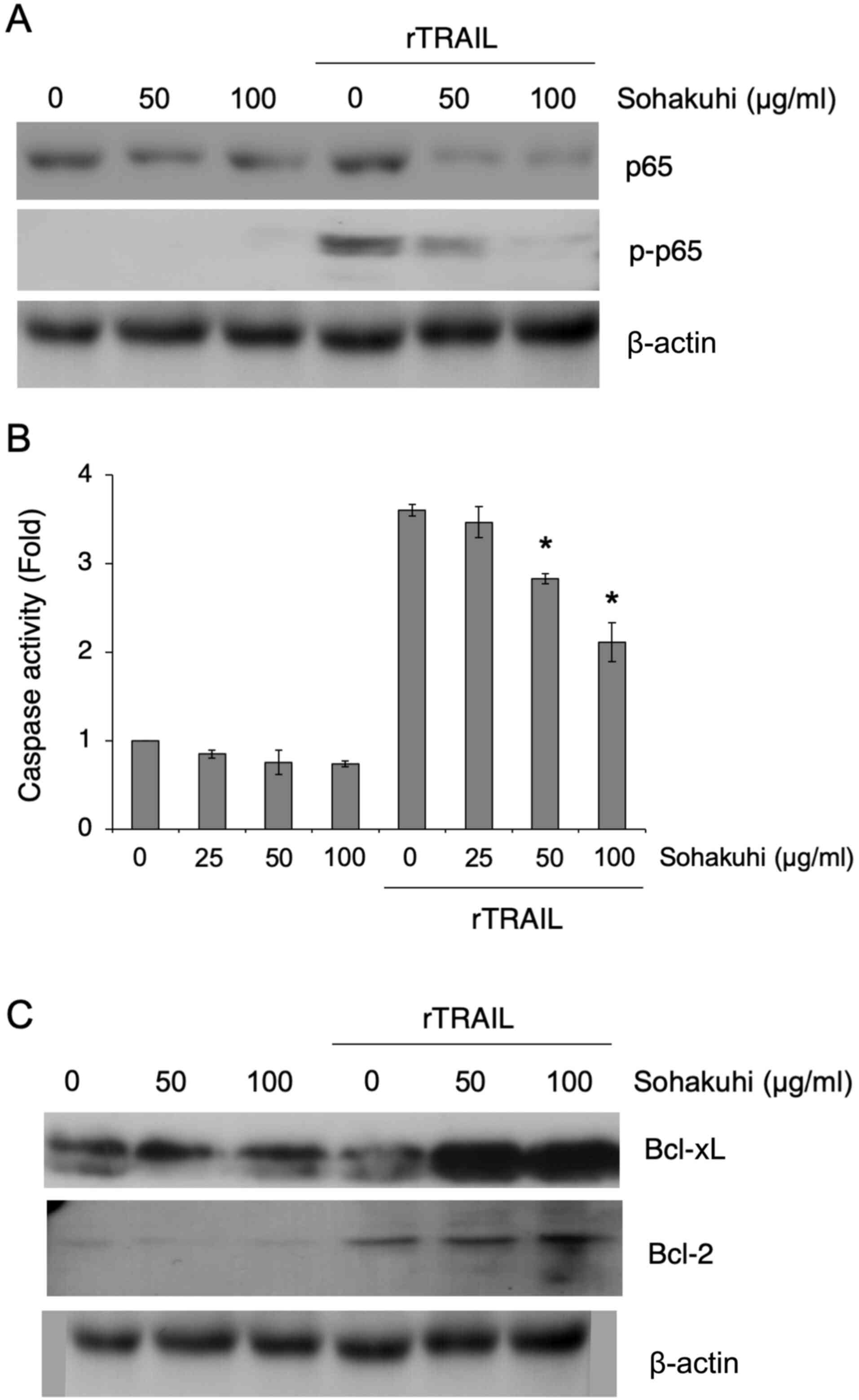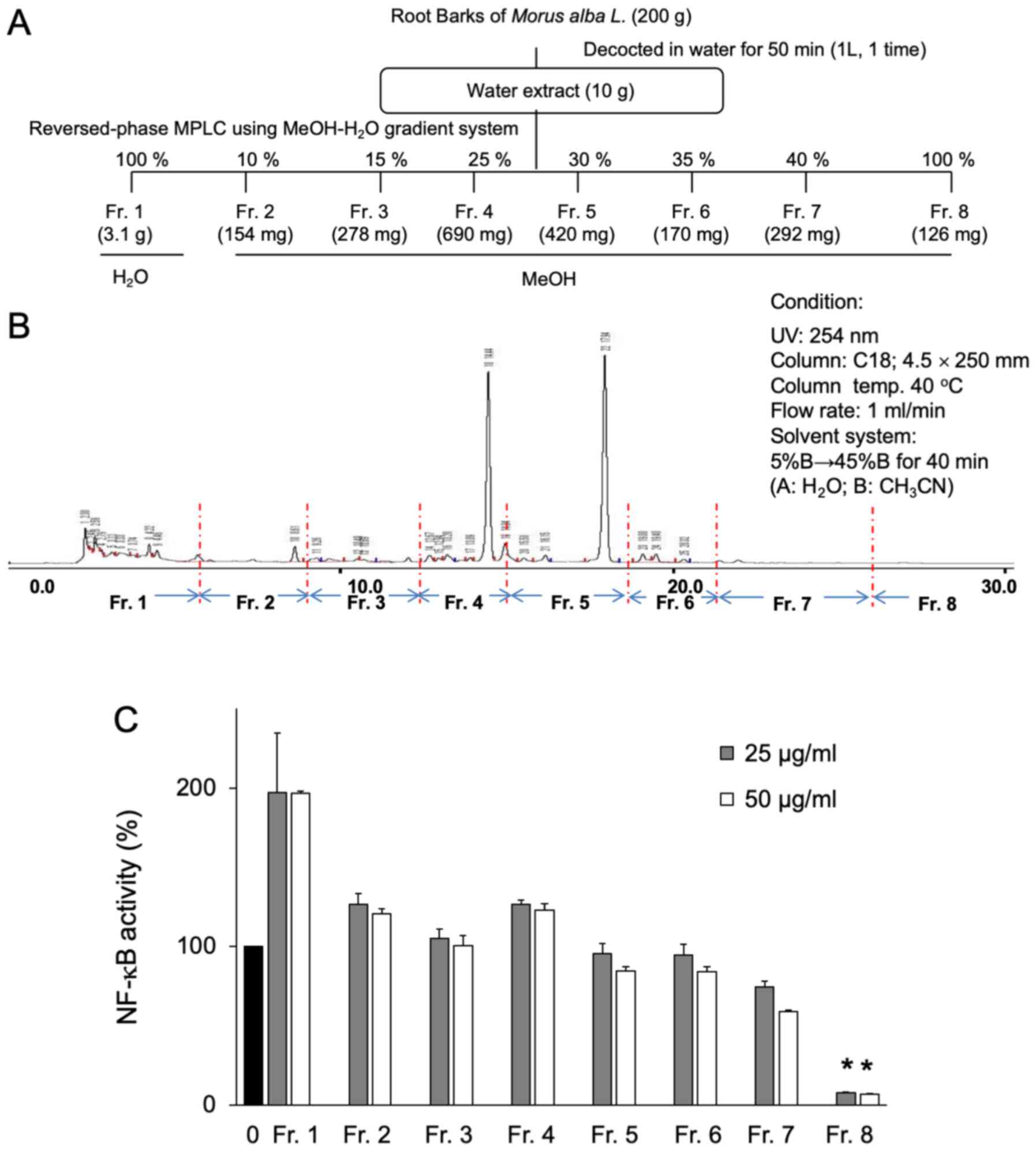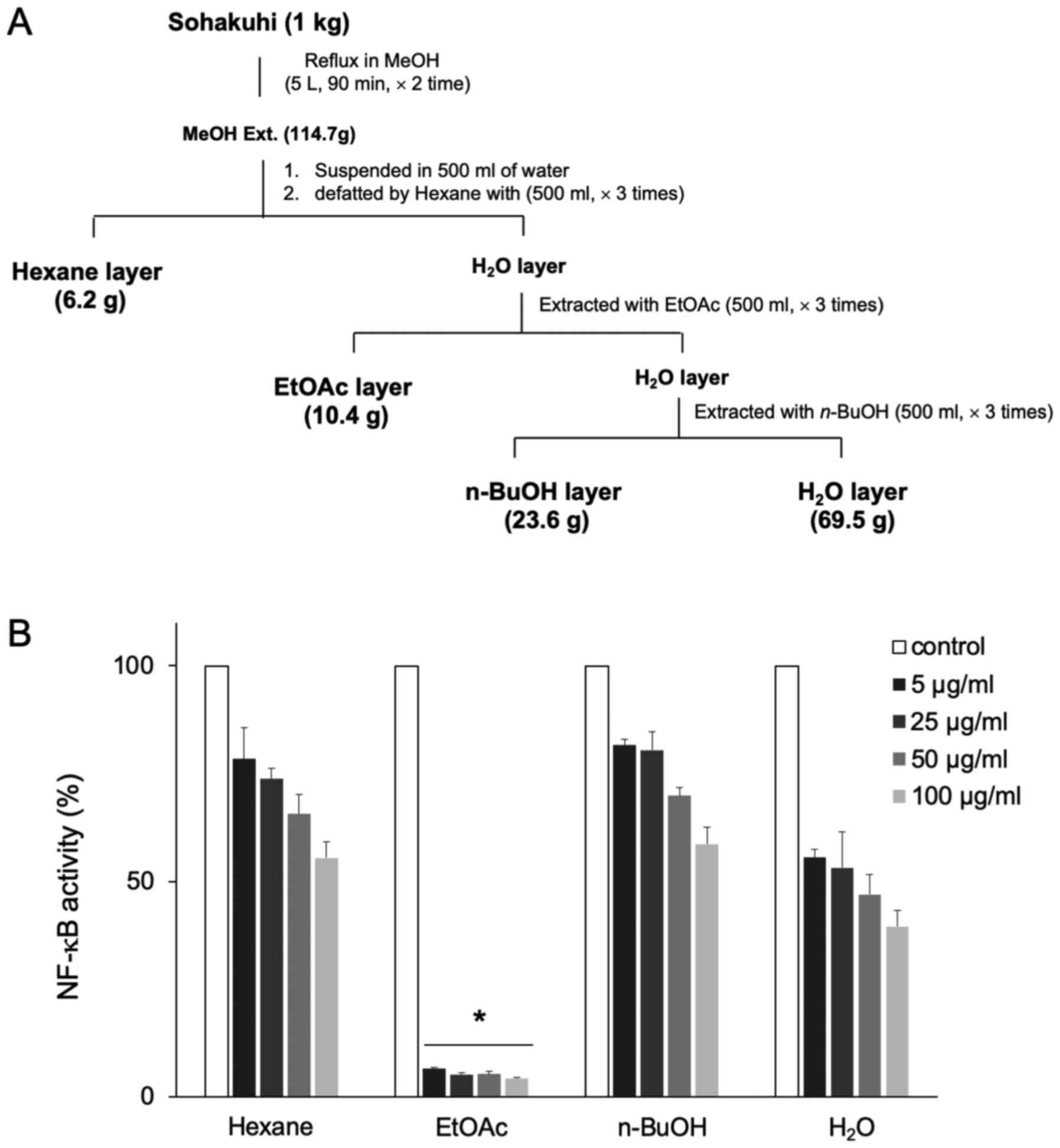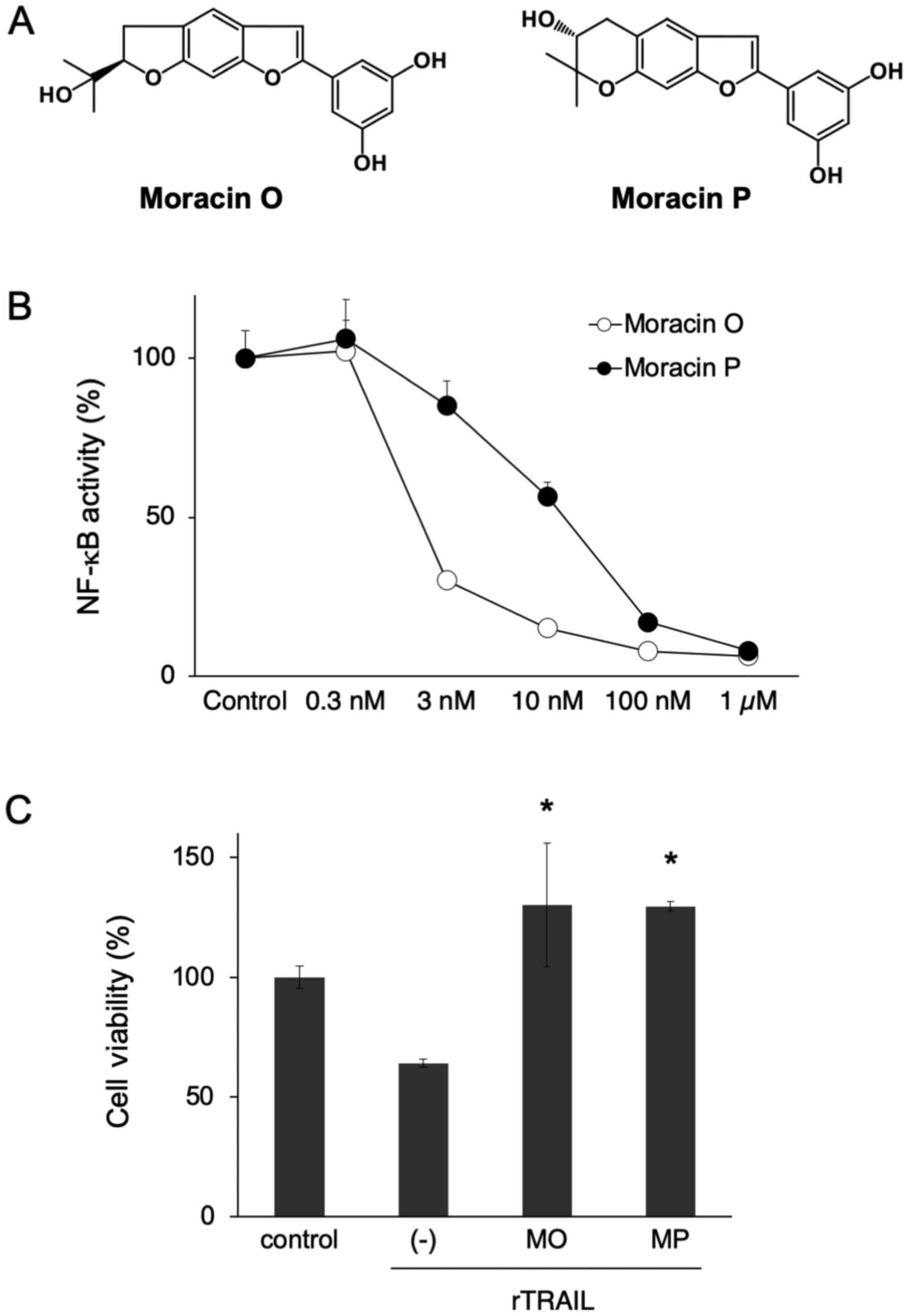|
1
|
Fachrudin N, Waltenberger B, Cabaracdic M,
Atanasov AG, Malainer C, Schachner D, Heiss EH, Liu R, Noha SM,
Grzywacz AM, et al: Identification of plumericin as apotent new
inhibitor of the NF-kB pathway with anti-inflammatory activity in
vitro and vivo. Br J Pharmacol. 171:1676–1686. 2014.PubMed/NCBI
|
|
2
|
Weis U: Inflammation. Nature.
454:4272008.PubMed/NCBI
|
|
3
|
Tabas I and Glass CK: Anti-Inflammatory
therapy in chronic disease: Challenenges and opportunities.
Science. 339:166–172. 2013.PubMed/NCBI
|
|
4
|
Patel M, Murugananthan and Gowda KPS: In
vivo animal models in preclinical evaluation of anti inflammatory
activity - A review. Int J Pharm Res Allied Sci. 1:01–05. 2012.
|
|
5
|
Lawrence T: The nuclear factor NF-kappaB
pathway in inflammation. Cold Spring Harb Perspect Biol.
1:a0016512009.PubMed/NCBI
|
|
6
|
Yuan Q, Zhang X, Liu Z, Song S, Xue P,
Wang J and Ruan J: Ethanol extract of adiantum capillus-veneris L.
Suppress the production of inflammatory mediator by inhibiting
NF-kB activation. J Ethnopharmacol. 147:603–611. 2013.PubMed/NCBI
|
|
7
|
Giuliani C, Bucci I and Napolitano G: The
role of the transcription factor nuclear factor-kappa B in thyroid
autoimmunity and cancer. Front Endocrinol (Lausanne).
9:4712018.PubMed/NCBI
|
|
8
|
Aggarwal BB and Shishodia S: Molecular
targets of dietary agents for prevention and therapy of cancer.
Biochem Pharmacol. 71:1397–1421. 2006.PubMed/NCBI
|
|
9
|
De Bont R and van Larebeke N: Endogenous
DNA damage in humans: A review of quantitative data. Mutagenesis.
19:169–185. 2004.PubMed/NCBI
|
|
10
|
Deng T, Lyon CJ, Bergin S, Caligiuri MA
and Hsueh WA: Obesity, inflammation, and cancer. Annu Rev Pathol.
11:421–449. 2016.PubMed/NCBI
|
|
11
|
Takahashi K, Takeda K, Saiki I, Irimura T
and Hayakawa Y: Functional roles of tumor necrosis factor-related
apoptosis-inducing ligand-DR5 interaction in B16F10 cells by
activating the nuclear factor-κB pathway to induce metastatic
potential. Cancer Sci. 104:558–562. 2013.PubMed/NCBI
|
|
12
|
Takhashi K, Nagai N, Ogura K, Tsuneyama K,
Saiki I, Irimura T and Hayakawa Y: Mammary tissue microenvironment
determines T cell-dependent breast cancer-associated inflammation.
Cancer Sci. 106:867–874. 2015.PubMed/NCBI
|
|
13
|
Flaczyk E, Kobus-Cisowska J, Przeor M,
Korczak J, Remiszewski M, Korbas E and Buchowski M: Chemical
characterization and antioxidative properties of polish variety of
Morus alba L, leaf aqueous extracts from the laboratory and
pilot-scale processes. Agriculture Sci. 4:141–147. 2013.
|
|
14
|
Amarowicz R, Pegg RB and Bautista DA:
Antibacterial activity of green tea polyphenols against escherichia
coli K 12. Nahrung. 44:60–62. 2000.PubMed/NCBI
|
|
15
|
Butt MS, Nazir A, Sultan MT and Schoen K:
Morus alba L.Nature's functioning tonic. Trends Food SciTechnol.
19:505–512. 2008.
|
|
16
|
Fukai T, Hano Y, Hirakura K, Nomura T,
Uzawa J and Fukushima K: Structures of two natural hypotensive
Diels-Alder type adducts, mulberrofuran F and G, from the
cultivated mulberry tree (Morus lhou KOIDZ). Chem Pharm Bull
(Tokyo). 33:3195–3204. 1985.PubMed/NCBI
|
|
17
|
Ueda S, Matsumoto J and Nomura T: Four new
natural diels-alder type adducts, Mulberrofuran E, Kuwanon Q, R,
and V from callus culture of Morus Alba, L. Chem Pharm Bull.
32:350–353. 1984.
|
|
18
|
Fukai T, Hano Y, Hirakura K, Nomura T and
Uzawa J: Structure of mulberrofuran H, A Novel 2-arylbenzofuran
derivative from the cultivated mulberry tree (Morus lhou (Ser.)
Koidz). Chem Pharm Bull. 32:808–811. 1984.
|
|
19
|
Chung KO, Kim BY, Lee MH, Kim YR, Chung
HY, Park JH and Moon JO: In-vitro and in-vivo anti-inflammatory
effect of oxyresveratrol from morus alba L. J Pharm Pharmacol.
55:1695–1700. 2003.PubMed/NCBI
|
|
20
|
Yang ZG, Matsuzaki K, Takamatsu S and
Kitanaka S: Inhibitory effects of constituents from Morus
alba var. multicaulis on differentiation of 3T3-L1 cells
and nitric oxide production in RAW264.7 cells. Molecules.
16:6010–6022. 2011.PubMed/NCBI
|
|
21
|
Kaur N, Xia Y, Jin Y, Dat NT, Gajulapati
K, Choi Y, Hong YS, Lee JJ and Lee K: The first total synthesis of
moracin O and moracin P, and establishment of the absolute
configuration of moracin O. Chem Commun (Camb). 14:1879–1881.
2009.
|
|
22
|
Dat NT, Jin X, Lee K, Hong YS, Kim YH and
Lee JJ: Hypoxia-inducible factor-1 inhibitory benzofurans and
chalcone-derived diels-alder adducts from Morus species. J Nat
Prod. 72:39–43. 2009.PubMed/NCBI
|
|
23
|
Xia Y, Jin Y, Kaur N, Choi Y and Lee K:
HIF-1α inhib-itors: Synthesis and biological evaluation of novel
moracin O and P analogs. Eur J Med Chem. 46:2386–2396.
2011.PubMed/NCBI
|
|
24
|
Khyade VB, Khyade VV, Khyade SV and Moser
MB: Influence of Moracin on DMBA-TPA induced skin tumerigenesis in
the mouse. Int J Bioassays. 3:3509–3516. 2014.
|
|
25
|
Baldwing AS Jr: The NF-kappaB and I kappa
B proteins: New discoveries and insights. Annu Rev Immunol.
14:649–683. 1996.PubMed/NCBI
|
|
26
|
Pahl HL: Activators and target genes of
Rel/NF-kappaB transcription factors. Oncogene. 18:6853–6866.
1999.PubMed/NCBI
|
|
27
|
Harper N, Farrow SN, Kaptein A, Cohen GM
and MacFarlane M: Modulation of tumor necrosis factor
apoptosis-inducing ligand-induced NF-kappaB activation by
inhibition of apical caspases. J Biol Chem. 276:34743–34752.
2001.PubMed/NCBI
|
|
28
|
Hu WH, Johnson H and Shu HB: Tumor
necrosis factor-related apoptosis inducing ligand receptors signal
NF-kappaB and JNK activation and apoptosis through distinct
pathways. J Biol Chem. 274:30603–30610. 1999.PubMed/NCBI
|
|
29
|
Jeremias I and Debatin KM: TRAIL induces
apoptosis and activation of NF-kappaB. Eur Cytokine Netw.
9:687–688. 1998.PubMed/NCBI
|
|
30
|
Keane MM, Rubinstein Y, Cuello M,
Ettenberg SA, Banerjee P, Nau MM and Lipkowitz S: Inhibition of
NF-kappaB activity enhances TRAIL mediated apoptosis in breast
cancer cell lines. Breast Cancer Res Treat. 64:211–219.
2000.PubMed/NCBI
|
|
31
|
Kim YS, Schwabe RF, Qian T, Lemasters JJ
and Brenner DA: TRAIL mediated apoptosis requires NF-kappaB
inhibition and the mitochondrial permeability transition in human
hepatoma cells. Hepatology. 36:1498–1508. 2002.PubMed/NCBI
|
|
32
|
Oya M, Ohtsubo M, Takayanagi A, Tachibana
M, Shimizu N and Murai M: Constitutive activation of nuclear
factor-kappaB prevents TRAIL-induced apoptosis in renal cancer
cells. Oncogene. 20:3888–3896. 2001.PubMed/NCBI
|
|
33
|
Southall MD, Isenberg JS, Nakshatri H, Yi
Q, Pei Y, Spandau DF and Travers JB: The platelet-activating factor
receptor protects epidermal cells from tumor necrosis factor (TNF)
alpha and TNF-related apoptosis-inducing ligand-induced apoptosis
through an NF-kappa B-dependent process. J Biol Chem.
276:45548–45554. 2001.PubMed/NCBI
|
|
34
|
Wang P, Du B, Yin W, Wang X and Zhu W:
Resveratrol attenuates CoCl2-induced cochlear hair cell
damage through upregulation of sirtuin1 and NF-κB deacetylation.
PLoS One. 8:e808542013.PubMed/NCBI
|















